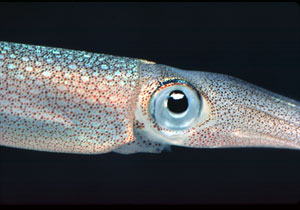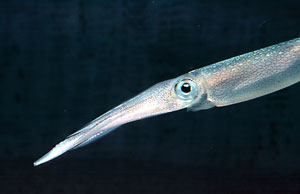 |

For further MBL News and Media Information, contact the MBL Communications Office at (508) 289-7423 or e-mail us at comm@mbl.edu
.
 |
|
Loligo pealeii (Longfin inshore squid)
Photo credit: Roger Hanlon
|
|
MBL Scientists Get on Squid's Nerves
Genome project launched to identify squid genes essential to disease researchers
Back to resources page
MBL, WOODS HOLE, MA - The next time you bite into a tasty order of fried calamari, consider this: scientists are interested in the calamari squid not for dinner, but for all it is teaching them about nerve cells and the neurological conditions that result when nerve cells malfunction.
That’s why scientists at the MBL (Marine Biological Laboratory) have recently launched the Squid Genome Project, a scientific collaboration to identify the genes of the long-finned squid—information they say will aid in the complex process of researching debilitating neurological diseases, including Multiple Sclerosis, Amyotrophic Lateral Sclerosis (ALS), Parkinson’s, Huntington’s, and Alzheimer’s disease.
The effort is being co-directed by MBL/NIH neuroscientist Joe DeGiorgis and Dutch researcher J. Peter H. Burbach, of the Rudolf Magnus Institute of Neuroscience, University Medical Center Utrecht, and supported by funding from the Laboratory of Neurobiology at the NIH and the Netherlands Brain Foundation HsN. The project unites scientists from around the world, including some of the 41 researchers who conducted squid research at the MBL this year.
Aside from being a seafood delicacy, the calamari squid has a nerve cell fiber, called a giant axon, which is 1,000 times wider than the average human axon and much easier to see and work with.
|
|
|
Joseph A. DeGiorgis
Photo credit: Tom Kleindinst
|
For more than 75 years, these locally available squid have helped MBL scientists demystify important nervous system functions, such as how nerve cells communicate; how proteins, organelles, and other cargoes are transported along the axon; and how nerves conduct electricity. Since all life forms have similar basic cellular functions, scientists can translate what they learn from a simple system like the squid’s to the more complex system in humans.
But researchers hoping to understand neurological diseases by studying squid have reached the point where they need genetic information. So they’ve set out to identify the genes that encode the proteins responsible for nerve cell function.
“Knowing who the players are will help us to figure out how they work and vastly increase the rate at which we make our discoveries,” says DeGiorgis. It is also the first step on the long road toward finding genetic targets in nerve cells that might be used for drug development and therapy.
Another goal of the Squid Genome Project is to help scientists studying genes associated with certain human diseases identify similar genes in squid. Such information could help them decide whether using squid would serve their research interests.
“There are many examples of scientists looking for specific genes expressed in squid nerve cells,” says DeGiorgis. “However, without genomic data, finding this information is time consuming and labor intensive. It’s like trying to find needle in a haystack.”
Recent results of the first round of lab work on the squid nerve cell have identified genes associated with Huntington’s, Niemann-Pick, and Alzheimer’s disease, and are already informing scientists working on these diseases.
 |
|
Photo credit: Roger Hanlon
|
|
For example, Stephen Sturley, a researcher in the pediatrics department at Columbia University Medical Center is now considering using the squid in his research on Niemann-Pick disease. “At the MBL last summer we performed some preliminary neurotransmission experiments with George Augustine [of Duke University Medical Center] using a drug that induces a Niemann-Pick type C disease state,” says Sturley. “There was a suggestion that the drug had some effect on the squid giant axon, and Joe’s observations that the genes are conserved in the squid led us to further believe this organism might be a good model to study the mechanisms of this disease.”
So far, DeGiorgis and his colleagues have identified more than 3,000 out of what they predict will total approximately 35,000 genes (compared with about 40,000 in humans). “It’s a good beginning, but it’s the tip of the iceberg, and completing the project is money dependent,” he says.
Unraveling the squid genome is critical to scientists who use, or want to use, the squid in their research. “Identifying the genes of research animals enables scientists to push forward at a much faster rate,” DeGiorgis says. “I can’t adequately say how much power you have when you have genomic information.”
The MBL is an international, independent, nonprofit institution dedicated to improving the human condition through creative research and education in the biological, biomedical and environmental sciences. Founded in 1888 as the Marine Biological Laboratory, the MBL is the oldest private marine laboratory in the Western Hemisphere. For more information, visit the MBL website.
Back to resources page
|